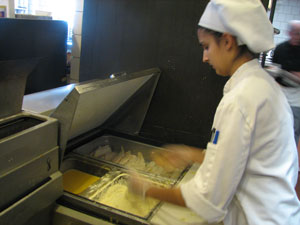
Students in the culinary arts program, many of whom don traditional white baking hats and uniforms, bustle around the kitchen, to prepare the day's dishes.
By Cathleen Twardzik
The aroma of cheeseburgers, chicken pot pie soup and brownies fills the air of The Highlander Cafe at Somerville High School, as students in the culinary arts program, many of whom don traditional white baking hats and uniforms, bustle around the kitchen, to prepare the day’s dishes.
The cafe is a student-operated restaurant, which is open to the public. Discover it for yourself in the Career and Technical Education wing.
Grab lunch or a baked good there from 11:15 a.m. to 1:15 p.m. each week on Wednesdays and Thursdays, and choose lunchtime staples, starting at $1.50 for a small salad or for a side, or meander in on Fridays for the all-you-can-eat buffet for $6.95.
Lunch and bakery items are available to pick up during that time, as well. Full-service catering can be arranged.
All of the students act in an extremely professional manner and will mostly go into the culinary business upon graduation. Therefore, they are expected to master everything that is involved in the operation of a restaurant – from preparing food, to waiting on patrons to running the cash register.
“Students are introduced to the basic fundamentals of cooking and baking. Throughout their high school career, they move onto advanced techniques. Let’s say, their saute skills improve greatly by the time they graduate. In the bakery, they become more adept at making dough and mixing,” said David Ginivisian, Lead Teacher of the culinary program at Somerville High School.
The program’s students’ represent each high school grade. Some of them partake in the program for all four years of high school, while others choose it as an elective for one or two years.
Professional quality equipment graces the state-of-the-art kitchen, which holds all stainless steel appliances.
Students use many different tools, so cutting boards and knives dot the room. In the line area – students make all of the food to order.
Over in the baking area, find cabinets, big flour bags and huge mixers, which are not quite five feet tall.
The kitchen, which holds countless stoves, leads out to the noticeably cooler dining room. The same red brick-like tiled floor is used throughout the space, which provides a cohesive look.
Immediately upon entering that section, the cash register, which gives an occasional ding, as its draw opens and closes, as well as the bakery greet each patron.
Part of a wall is reserved for the bakery counter – complete with a viewing window, so that patrons may see all of the baked goods on display.
Fancily wrapped specialty chocolate lollipops for Valentine’s Day rest atop the counter.
Young and old patrons produce minimal noise, as they enjoy lunch in the dining room.
Daylight streams in through the windows at midday. The wall of windows allows ample light to shine into the room to light up lunch. The wall and a half of red drapes with designs cover about one-quarter of each one.
Upon arriving at your table, as you sink into the armless chairs with deep brown trim and red cushions, you will notice that the silverware is neatly placed atop folded white paper napkins, light brown wicker bread basket, and water glasses.
To finish the look, a bouquet of tulips in a white vase is present. Red scalloped paper, but tasteful, placemats adorn the gray tabletops, which are trimmed in chocolate brown.
Promise, as well as two hard types of butter for the warm, fluffy dinner rolls, which jumpstart the meal, are located elsewhere on the eating surface. A coffee pitcher and salt and pepper shakers, as well as sweetener or sugar are available.
Finally, it’s time to dig in. As a grilled chicken sandwich is set down, coleslaw and a dill pickle complete the lunch’s look.
Importantly, students switch jobs every two weeks, including waiting tables, cooking, and doing the dishes. Set up and clean up are also part of that cycle. Equipment safety is also covered.
“No two days are alike because students come and go throughout the day. The food changes all the time, so they’re exposed to new things,” Ginivisian said.
Tom Cardon, another teacher in the culinary program at SHS founded it, according to Ginivisian.
In fact, this year marks the program’s 31st year. At present, approximately 60 students display their talent in it.
After having finished high school, students enter certificate programs. Otherwise, they go on to two year culinary schools, four year colleges or directly into the workforce.
Sandro Joseph, senior in the culinary program at Somerville High School, has a long-time interest in cooking. He “learned a lot” by participating in the culinary program.
After high school, Joseph will go to a community college and major in culinary arts.
He wants to become “a master chef and open up a restaurant” with John Cruz, senior in the culinary program at Somerville High School.
Cruz’s favorite part of the program is, “Making a recipe, and seeing the finished product.” He believes that the Boston or Somerville location is an ideal one, in which to start a restaurant – although, he and Joseph are considering another area of Massachusetts.
Cruz’ future plans involve attending a two year school. However, he is “not sure if culinary would be my main focus.” He is considering majoring in business and wants to be a restaurant manager or owner – not a full-time cook.
To place your order at the cafe, call ahead at (617) 625-6600 x6232 — although, if it is before 11 a.m., then, there is also an online form at www.somerville.k12.ma.us/cafe, if you would rather complete the process that way. Be sure to include your name, call-back number and the time, at which you would like to pick up your meal.















Reader Comments